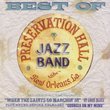| All Artists: Johannes Brahms, Murray Perahia Title: Brahms: Piano Sonata No. 3, Rhapsodies, Intermezzo, Capriccio Members Wishing: 0 Total Copies: 0 Label: Sony Original Release Date: 1/1/1991 Re-Release Date: 9/26/1991 Genre: Classical Styles: Opera & Classical Vocal, Forms & Genres, Sonatas, Historical Periods, Romantic (c.1820-1910) Number of Discs: 1 SwapaCD Credits: 1 UPC: 074644718126 |
Search - Johannes Brahms, Murray Perahia :: Brahms: Piano Sonata No. 3, Rhapsodies, Intermezzo, Capriccio
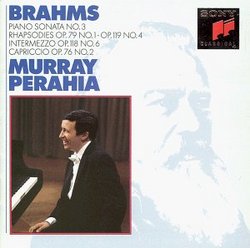 | Johannes Brahms, Murray Perahia Brahms: Piano Sonata No. 3, Rhapsodies, Intermezzo, Capriccio Genre: Classical
|
Larger Image |
CD DetailsSimilar CDs
Similarly Requested CDs
|
CD ReviewsThis Is As Good As It Gets! Ramírez Luna | USA | 03/25/2005 (5 out of 5 stars) "Mr. Perahia has helped us to see Brahms in a new light. His readings appreciate the magnificence of the forest but also the beauty of every tree and every leaf. The sonata No. 3, especially the second movement, will make many of you cry. This is art of the highest order." Resplendent David Saemann | 12/04/2008 (5 out of 5 stars) "Perahia recorded this disc after his period of study with Horowitz. Perahia quotes Horowitz as saying, In order to be more than a virtuoso, you first must be a virtuoso. Suffice to say that on this recording, Perahia is more than a virtuoso. His mastery of this music is so consummate that I yearn for him to record the Brahms Piano Concertos. In the Sonata, Perahia has the gift of making each movement seem just as long as it should be. This is often a problem in the Brahms Sonatas, which are early works and can seem to ramble from time to time. Nevertheless, whether it's in the delicate expression of the slow movement or in the unbuttoned attitude of the Scherzo, Perahia characterizes the music fully without ever losing the sense of the Sonata's structure and pacing. And as for virtuosity, Perahia's command of balances and sonorities is just fantastic. The sound engineering in the Sonata, from UCLA's Royce Hall (where the L.A. Phil. often recorded), is full but a little dull. The sound is better in the four shorter works, recorded one year later in a hall in Hamburg. Perahia has the measure of these later ruminations by Brahms, never finding a mood that is too recondite to project. And his tone in these works is just marvelous and apropos. Here's hoping that Perahia returns to Brahms in the now later stages of Perahia's career." A generous quantity of Brahms; generous in quality too. Tom Brody | Berkeley, CA | 12/08/2009 (5 out of 5 stars) "This disc contains four piano pieces, totaling 60 minutes and 23 seconds. The piano was recorded with the microphone up close. The only echoes are from those occurring within the piano. There are no discernable room echoes (echos from the walls of the room). The sound quality of this recording is sharp and never muddy. The following is a review of Piano Sonata No. 3.
I. ALLEGRO. A descending motif begins, with thrashing chords in the lower register, reminiscent of Brahm's Piano Quartet No. 3 (4 ½ to 5 ½ minutes into Allegra ma non troppo of the Piano Quartet No. 3). At 4 minutes begins a quiet but motoristic segment reminiscent of the opening notes of Brahms' Piano Concerto No. 2 (opening notes of allegro appassionato). At five minutes, and again at seven minutes and 40 seconds, the thrashing descending motif returns. Then there are loud parts, soft parts, loud parts, soft parts. II. ANDANTE. This starts out slowly, sounding like the adagio of Beethoven's Piano Sonata No. 8 (Pathetique). From 3 minutes 40 seconds to 4 minutes, we hear a melody sounding like LET IT BE ME, by the Everly Brothers. From 4 min 40 seconds to 5 minutes, we hear LET IT BE ME, again. From 8 minutes to 9 minutes we hear a tune accompanied by an A flat bass note, repeated over and over and over, in the manner of a drone. III. SCHERZO. This starts as a lively waltz. Then, after 20 seconds, the waltz becomes an inverted waltz where the first of the three beats is subdued, rather than accented. This is the same type of effect found in reggae music, where what normally would be an accented first note is played in a manner that is totally devoid of any accent (this is the distinguishing factor of reggae music). At 1 minute and 25 seconds comes another episode -- not a waltz -- that has an anthemic quality, or perhaps sounding like a childrens' Sunday school song. At 3 minutes and 15 seconds, the lively waltz returns, and the waltz continues to the end. IV. INTERMEZZO. There is a slow descending motif, interrupted by loud Beethovenesque DIT-DIT-DIT-DAH motifs in the lower register. The Intermezzo is only 3 ½ minutes long, and we hear plenty of DIT-DIT-DIT-DAH motifs, obviously influenced by Beethoven's Symphony No. Five. In two other Brahms pieces, we also hear the DIT-DIT-DIT-DAH motif. DIT-DIT-DIT-DAH is found at the 5-minute mark in the Scherzo of Piano Sonata No.1, and also at the 5-minute mark of the Finale of Piano Sonata No.2. Charles Ives also used this DIT-DIT-DIT-DAH motif in his piano sonata. V. FINALE. The Finale has a unique start-and-stop motif. At 3 minutes and 20 seconds, we hear what sounds like a patriotic high school song. The patriotic high school song lasts only 40 seconds. At 5 minutes and 45 seconds, we hear what seems like a fast fugue on the patriotic high school song. It is surprising how little the style and melodies of Brahms' Piano Sonata No. 3 resemble that of his piano quartets and piano quintet. Actually, I was hoping that the Brahms piano sonatas would closely resemble these other pieces, but they do not. The Brahms piano sonatas seem to be lacking in "Brahmsiness." In fact, the Brahms piano sonatas seem to have been composed by a different composer. The piano sonatas seem to be "Brahms lite" in that the melodies are more straightforward while, in contrast, the Brahms piano quartets and quintet seem more intellectual, requiring more concentration on the part of the listener, in a manner reminiscent of the later Beethoven piano sonatas. FIVE STARS. Brahms-lovers might want to be on the lookout for a series of four hand versions, from Naxos, of the symphonies, piano concertos, German Requiem, and chamber music, as recorded by Christian Kohn and Silke-Thora Matthies. " |

 Track Listings (9) - Disc #1
Track Listings (9) - Disc #1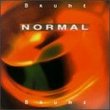



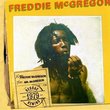
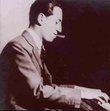
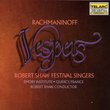


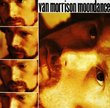
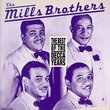
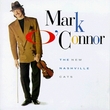

![Gershwin: Porgy & Bess [With Members of the Original Cast]](https://nationalbookswap.com/cd//m/71/7871/117871.jpg)
